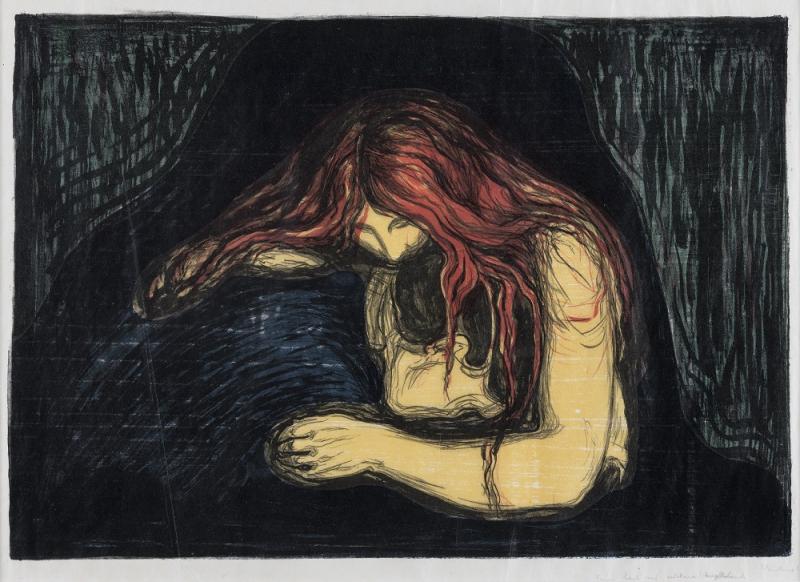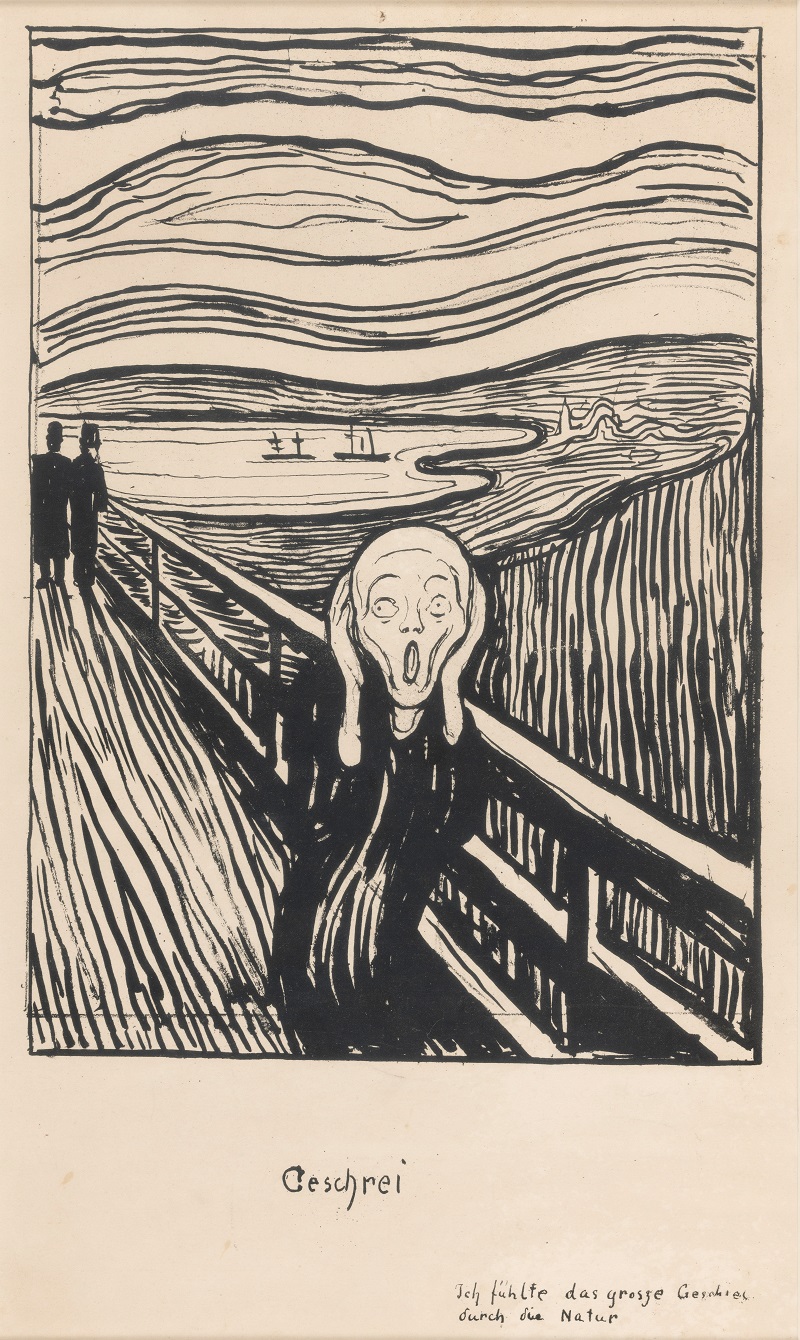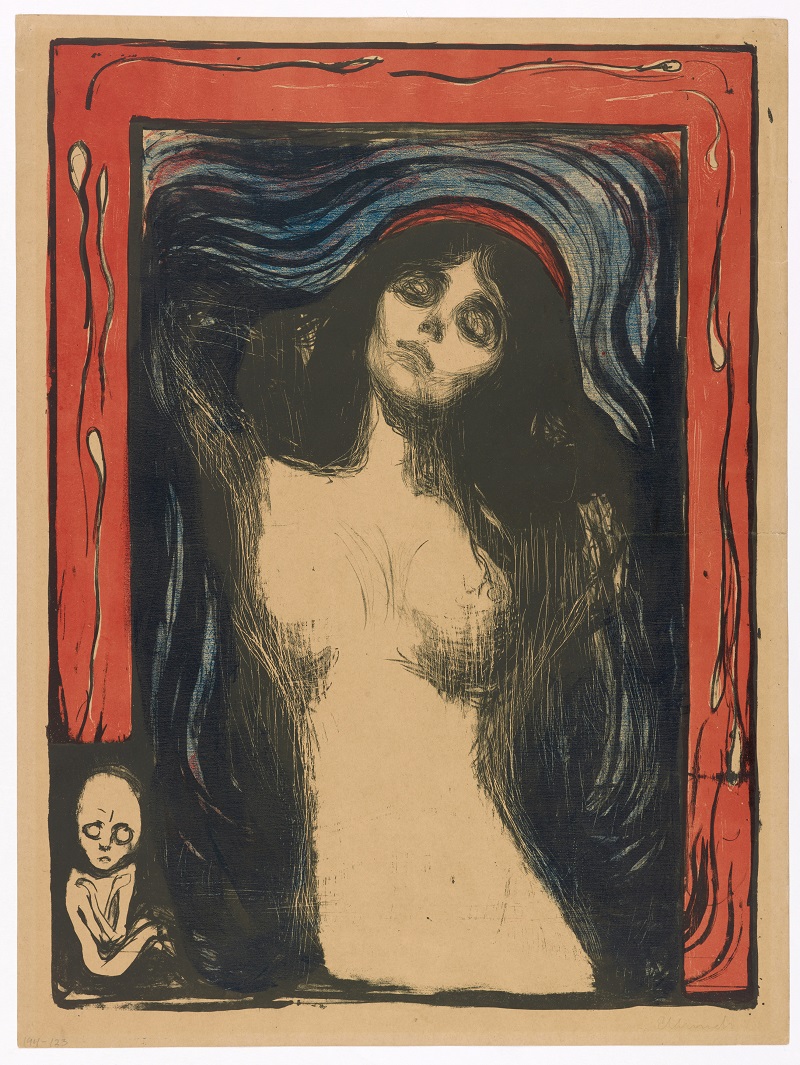Edvard Munch: Love and Angst, British Museum review - compassion in the age of anxiety | reviews, news & interviews
Edvard Munch: Love and Angst, British Museum review - compassion in the age of anxiety
Edvard Munch: Love and Angst, British Museum review - compassion in the age of anxiety
Norway's greatest painter revealed as a master printmaker

Munch’s The Scream is as piercing as it has ever been, and its silence does nothing to lessen its viscerally devastating effect. It was painted in 1893, but it was a lithograph produced two years later – now the star of the biggest UK exhibition of Munch’s prints for a generation – that would make it famous.
 The nuances of suffering are here in all their shades: love and angst, certainly, but grief and loss, jealousy and loneliness are lived and reproduced in us as we look. For all Munch’s agonised introspection, the sharing of experience is integral to the peculiar potency of his work. If The Scream (Pictured right) describes the sensations of witnessing another’s pain, then this is also the nature of our transaction with Munch when we look at his work. He relies upon our compassion, and in doing so surely reveals a surprisingly optimistic faith in human nature.
The nuances of suffering are here in all their shades: love and angst, certainly, but grief and loss, jealousy and loneliness are lived and reproduced in us as we look. For all Munch’s agonised introspection, the sharing of experience is integral to the peculiar potency of his work. If The Scream (Pictured right) describes the sensations of witnessing another’s pain, then this is also the nature of our transaction with Munch when we look at his work. He relies upon our compassion, and in doing so surely reveals a surprisingly optimistic faith in human nature.
For all that, there’s not much here to be optimistic about, and his explorations of the bonds of love pulse with the anticipation of loss. Munch took up printmaking a decade or so after he began painting, partly perhaps, because he saw a better prospect of making money this way. That aside, his early aptitude, and his innovative approach show his affinity with the medium, which suited his habit of returning again and again to certain subjects.
One such subject is The Kiss: by 1902 the entwined male and female figures had been reduced to an emblem, printed in black over a grey toning block. The simplification of the image does nothing to reduce its emotional force: on the contrary, the use of an uncut toning block to transfer only the grain of the wood to the page has a remarkable effect. The couple’s bond is made permanent, and yet this brings no comfort: trapped within the fibre of the tree they are helpless.
Fatalism stalked Munch: both his mother and sister had died from tuberculosis, and in 1926 his sister Laura, who had been afflicted with a form of schizophrenia since adolescence, died of cancer. Munch was convinced that both tuberculosis and mental illness were hereditary, and he wrote: “Disease and Insanity and Death were the black Angels that stood by my Cradle”.
Nothing occupied Munch quite like his dread of women, however. Munch’s own difficult experiences of love inform his work to the extent that his patron, Harry Kessler, said: “More than anything he is a depicter of women.” Fascination is counterweighted by fear, with women in their prime depicted as awesome and sexually voracious creatures.
 Summer Night: the Voice, 1894, one of the earliest images from the Frieze of Life series produced by Munch in the 1890s and beyond, is associated with his first serious love affair. Its subject, Milly Thaulow, is simultaneously girlish and otherworldly. Her face described in radiating circles, she is an emanation so brilliant that the moon reflected in the water beyond is a dull glow in comparison. Remote and unreachable, she might slip away into the forested half-light at any moment.
Summer Night: the Voice, 1894, one of the earliest images from the Frieze of Life series produced by Munch in the 1890s and beyond, is associated with his first serious love affair. Its subject, Milly Thaulow, is simultaneously girlish and otherworldly. Her face described in radiating circles, she is an emanation so brilliant that the moon reflected in the water beyond is a dull glow in comparison. Remote and unreachable, she might slip away into the forested half-light at any moment.
Female power is sexual and overwhelming: in a repurposing of the three ages of man, a woman in mid-life thrusts her body towards us, her limbs outstretched like a spider in its web. Men become entangled and sometimes consumed by female hair (Main picture), while in Madonna, 1895/1902 (Pictured above left), sperm swim decoratively around a border, like flies drawn unwittingly to a web.
The no doubt sensible view of the show’s curators is that hard drinking and free love did nothing to improve Munch’s state of mind. The artists and writers he encountered in his hometown of Kristiania while still in his twenties are portrayed in his disquieting etching Kristiania Bohemians, 1895. Jealousy, the toxic by-product of free love, seeps through it, its source the central, malign figure of artist Oda Lasson at one end of the table, or rather, perhaps, the bottle of wine, or schnapps, at the other.
If Munch’s personal relationships and chaotic way of life worsened his psychological distress, it is surely the case that even without the disruptive influence of this formative group of friends, growing up in Kristiania would have been discombobulating enough. The city’s systemic hypocrisy was exemplified by the co-existence of oppressive Lutheranism and a flourishing sex trade. Syphilis was a constant, looming threat: incurable, deadly and heritable, it seems likely to have been formative in Munch’s fatalistic outlook, and his obsessive fixation with “bad blood”.
Society’s hypocrisy, and the devastation caused by syphilis were topics explored by Munch’s fellow Norwegian, Henrik Ibsen, and Munch’s friendships with Scandinavian artists and writers in Paris resulted in a new strand of work that forms the focus of the final part of the exhibition. Munch, along with Toulouse-Lautrec and Vuillard, designed programmes and stage sets for avant-garde theatre companies in Paris, providing an opportunity for Munch to explore his favoured themes with renewed focus. Seen in this broader context, Munch is less of an oddity, and we can see him as part of a widespread age of anxiety, as modernity collided with the divisive norms of 19th century society.
rating
Share this article
The future of Arts Journalism
You can stop theartsdesk.com closing!
We urgently need financing to survive. Our fundraising drive has thus far raised £49,000 but we need to reach £100,000 or we will be forced to close. Please contribute here: https://gofund.me/c3f6033d
And if you can forward this information to anyone who might assist, we’d be grateful.

Subscribe to theartsdesk.com
Thank you for continuing to read our work on theartsdesk.com. For unlimited access to every article in its entirety, including our archive of more than 15,000 pieces, we're asking for £5 per month or £40 per year. We feel it's a very good deal, and hope you do too.
To take a subscription now simply click here.
And if you're looking for that extra gift for a friend or family member, why not treat them to a theartsdesk.com gift subscription?
more Visual arts
 'We are bowled over!' Thank you for your messages of love and support
Much-appreciated words of commendation from readers and the cultural community
'We are bowled over!' Thank you for your messages of love and support
Much-appreciated words of commendation from readers and the cultural community
 Photo Oxford 2025 review - photography all over the town
At last, a UK festival that takes photography seriously
Photo Oxford 2025 review - photography all over the town
At last, a UK festival that takes photography seriously
![SEX MONEY RACE RELIGION [2016] by Gilbert and George. Installation shot of Gilbert & George 21ST CENTURY PICTURES Hayward Gallery](https://theartsdesk.com/sites/default/files/styles/thumbnail/public/mastimages/Gilbert%20%26%20George_%2021ST%20CENTURY%20PICTURES.%20SEX%20MONEY%20RACE%20RELIGION%20%5B2016%5D.%20Photo_%20Mark%20Blower.%20Courtesy%20of%20the%20Gilbert%20%26%20George%20and%20the%20Hayward%20Gallery._0.jpg?itok=7tVsLyR-) Gilbert & George, 21st Century Pictures, Hayward Gallery review - brash, bright and not so beautiful
The couple's coloured photomontages shout louder than ever, causing sensory overload
Gilbert & George, 21st Century Pictures, Hayward Gallery review - brash, bright and not so beautiful
The couple's coloured photomontages shout louder than ever, causing sensory overload
 Lee Miller, Tate Britain review - an extraordinary career that remains an enigma
Fashion photographer, artist or war reporter; will the real Lee Miller please step forward?
Lee Miller, Tate Britain review - an extraordinary career that remains an enigma
Fashion photographer, artist or war reporter; will the real Lee Miller please step forward?
 Kerry James Marshall: The Histories, Royal Academy review - a triumphant celebration of blackness
Room after room of glorious paintings
Kerry James Marshall: The Histories, Royal Academy review - a triumphant celebration of blackness
Room after room of glorious paintings
 Folkestone Triennial 2025 - landscape, seascape, art lovers' escape
Locally rooted festival brings home many but not all global concerns
Folkestone Triennial 2025 - landscape, seascape, art lovers' escape
Locally rooted festival brings home many but not all global concerns
 Sir Brian Clarke (1953-2025) - a personal tribute
Remembering an artist with a gift for the transcendent
Sir Brian Clarke (1953-2025) - a personal tribute
Remembering an artist with a gift for the transcendent
 Emily Kam Kngwarray, Tate Modern review - glimpses of another world
Pictures that are an affirmation of belonging
Emily Kam Kngwarray, Tate Modern review - glimpses of another world
Pictures that are an affirmation of belonging
 Kiefer / Van Gogh, Royal Academy review - a pairing of opposites
Small scale intensity meets large scale melodrama
Kiefer / Van Gogh, Royal Academy review - a pairing of opposites
Small scale intensity meets large scale melodrama
 Jenny Saville: The Anatomy of Painting, National Portrait Gallery review - a protégé losing her way
A brilliant painter in search of a worthwhile subject
Jenny Saville: The Anatomy of Painting, National Portrait Gallery review - a protégé losing her way
A brilliant painter in search of a worthwhile subject
 Abstract Erotic, Courtauld Gallery review - sculpture that is sensuous, funny and subversive
Testing the boundaries of good taste, and winning
Abstract Erotic, Courtauld Gallery review - sculpture that is sensuous, funny and subversive
Testing the boundaries of good taste, and winning
 Edward Burra, Tate Britain review - watercolour made mainstream
Social satire with a nasty bite
Edward Burra, Tate Britain review - watercolour made mainstream
Social satire with a nasty bite

Add comment